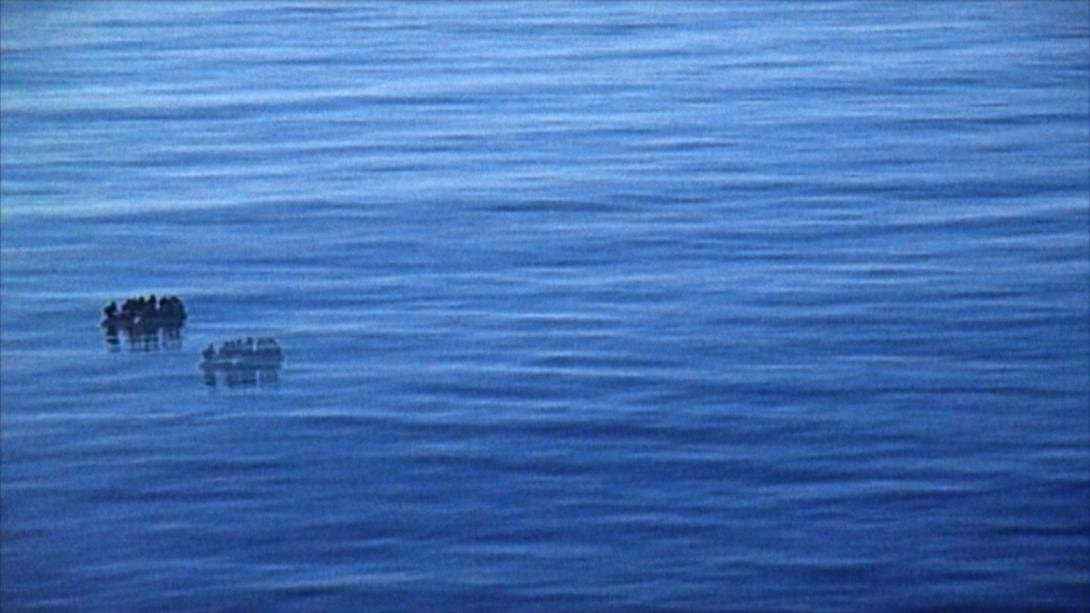
Synopsis
Die Koordinaten 37°28.6'N und 0°3.8'E markieren einen Punkt im Mittelmeer – 38 Seemeilen vor der Hafenstadt Cartagena in Spanien oder 100 Seemeilen von der algerischen Hafenstadt Oran entfernt – je nach Perspektive der Erzählung. Von diesem Punkt im Meer aus betrachtet, besteht die ganze Welt aus Wasser, Himmel und einem grenzenlosen Horizont. Ein „Meer der Möglichkeiten“, aufgeladen mit Hoffnungen, Ängsten und Träumen von Reisenden.
Am 14. September 2012 um 14.56 Uhr meldet das Kreuzfahrtschiff „Adventure of the Seas“ der spanischen Seenotrettung auf diesen Koordinaten die Sichtung eines manövrierunfähigen Schlauchbootes mit 13 Personen an Bord.
In Sichtweite.
90 Minuten.
Winken.
Warten.
Der Funkverkehr zwischen dem Kreuzfahrtschiff, der Zentrale im Hafen von Cartagena, dem Seenotrettungskreuzer "Salvamar Mimosa" und dem Helikopter "Helimer 211" strukturiert den akustischen Raum des Films. Auf der Bildebene zieht sich der filmische Raum zu einer einzigen, ungeschnittenen Sequenz zusammen, die sich über die gesamte Laufzeit des Films wölbt. Es ist ein kurzer Youtube-Clip, der uns heute wie die Essenz, die Verdichtung der Situation auf dem Mittelmeer erscheint. In Einzelbildern wird das Schlauchboot mit 13 Gestalten an Bord zur Ikone der täglichen Nachrichtenbilder, wir sind gezwungen hinzusehen.
Aus Aufnahmen mit Touristen und Offizieren auf dem Cruise Liner, mit der Besatzung eines Containerschiffes, mit Harraga, les bruleurs - "die ihre Pässe verbrennen", und ihren Familien werden die biografischen Fluchtlinien des dokumentarischen Materials in eine filmische Imagination hinein verlängert.
Es entsteht eine Choreografie, in der sich Vergangenheit, Gegenwart und Zukunft der Reisenden spiegeln: Wird ein anderer, ein neuer Möglichkeitsraum sichtbar, wenn sie sich erneut – im filmischen Raum – begegnen?
Credits
mit
Frankreich Rhim Ibrir Algerien Abdallah Benhamou, Houcin Ouahiani, Houria Kourad Containerschiff „Smaragd“ Leonid Savin, Dmitriy Simonov, Oleg Vashchenko, Artem Zaporozhets, Oleksiy Shelyakin, Sergiy Isayev, Vicente Bautista, Osmundo Fuertes, Mardion Arong, Johnrey Alvarado, Ryan Magdua, Clark Jhun Cantoria, Ron Toledo, Danilo De Leon Kreuzfahrtschiff „Adventure of the Seas“ Guillaume Coutu-Lemaire, Emma Gillings Nordirland Terry Diamond, Jackie Kelly
Buch Merle Kröger, Philip Scheffner
Regie/Schnitt Philip Scheffner
Kamera Terry Diamond, Bernd Meiners
Ton Pascal Capitolin, Volker Zeigermann
Sound Design Volker Zeigermann, Alexander Gerhardt, Philip Scheffner
Kinomischung Florian Marquardt
Bildmastering Matthias Behrens
Produzentinnen Merle Kröger, Caroline Kirberg
Koproduzent*innen
Meike Martens, Marcie Jost, Peter Zorn
Redaktion Doris Hepp
Eine Produktion von pong
In Koproduktion mit
Blinker Filmproduktion, worklights media production
sowie mit ZDF in Zusammenarbeit mit ARTE
Recherche gefördert durch Robert Bosch Stiftung
Entwicklung gefördert durch FFA Filmförderungsanstalt
Produktion gefördert durch
Medienboard Berlin Brandenburg
BKM
Deutscher Filmförderfonds
Filmförderung Hamburg Schleswig-Holstein
Mitteldeutsche Medienförderung
Film und Medien Stiftung NRW
Kontakt Kinoverleih (Deutschland)
Real Fiction Filmverleih
Tel: +49 (0)221 9522 111
Email info(at)realfictionfilme.de
Kontakt World Sales
FIRST HAND FILMS
Email: sales(at)firsthandfilms.com
Tel: +41 (0)44 312 20 60
Kontakt Produktion pong
Caroline Kirberg
Email: kirberg(at)pong-berlin.de
Visuals
Mehr Infos
-
festivals
Weltpremiere: Berlinale Internationale Filmfestspiele Berlin | Forum 2016
Internationale Premiere: FID Marseille 2016Weitere Festivals (Auswahl):
- European Media Art Festival Osnabrück
- New Horizons Film Festival Wroclaw
- Split Film Festival
- Berwick Film & Media Arts Festival
- L'Age d'Or Festival Brussels
- Underdox Festival München
- Carthague Film Festival Tunisia
- Inconvenient Films Festival Vilnius
- Duisburger Filmwoche
- Festival of German Cinema Beijing
- Rencontres Internationales du Documentaire de Montréal
- DOKfest Kassel
- L'Alternativa Festival Barcelona
- Torino Film Festival
- Museum of the Moving Image, New York City
- SANFIC - Santiago de Chile
-
preise
- Special Mention | Prix George Beauregard International | FID Marseille 2016
- ARTE Dokumentarfilmpreis | Duisburger Filmwoche 2016
- Best International Feature Film | L'Alternativa Barcelona 2016
- Best editing in an international feature | RIDM - Montreal International Documentary Festival 2016
-
buch
HAVARIE | Merle Kröger | Roman
erschienen im Argument Verlag Hamburg, Mai 2015
Die Recherche zum Dokumentarfilm HAVARIE war Ausgangspunkt und Inspiration für den gleichnamigen Roman von Merle Kröger: "Die Realität ist viel dramatischer, gewalttätiger, unfassbarer als die Fiktion. Ich habe mich entschieden, das reale Ereignis des Aufeinandertreffens der Schiffe zum Anlass zu nehmen, um die Zeit anzuhalten, quasi ein 3-D-Modell dieser Situation zu erstellen, das ich von allen Seiten betrachten kann. In diesem modellhaften Raum kann ich nun in die Rolle jedes Protagonisten schlüpfen und versuchen, ihn oder sie aus ihrer Biografie heraus denken und handeln zu lassen."
Auszeichnungen:
• KrimiZeit Bestenliste Platz 1 (Juni, Juli & August 2015)
• Hotlist 2015
• Radio Bremen Krimipreis 2015
• Deutscher Krimipreis 2016, 2. Platz (national) -
fact sheet
Produktionsland: Deutschland
Produktionsjahr: 2016
Länge: 93 Minuten
Bildformat: DCP, 4:3, Farbe
Tonformat: 5.1 / Stereo
Sprachfassungen: Original mit englischen, deutschen oder französischen Untertiteln
Auf DVD erhältlich bei Filmgalerie 451